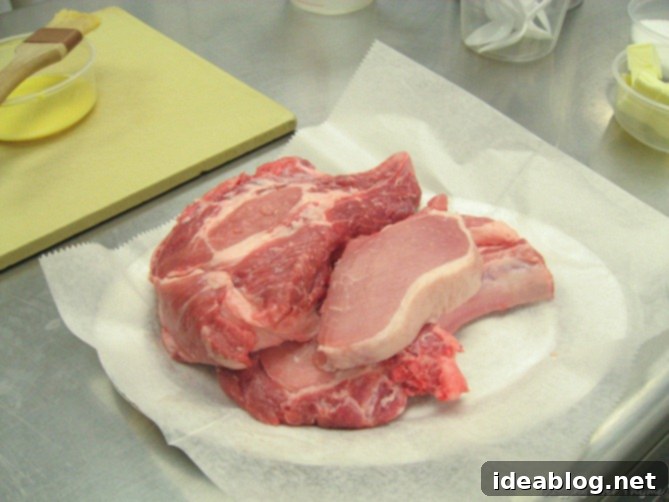Mastering Classic French Cuisine: A Day of Pork, Puree, Gaspacho, and Éclairs at Culinary School
Today marks another intensive day in our culinary journey, bringing us closer to mastering the intricate world of French cuisine. As I juggle studying for our upcoming practical and theory test this Thursday, I wanted to share the fascinating dishes and techniques we explored today. It was a day filled with new experiences, from handling a new protein to perfecting classic sauces and pastries.
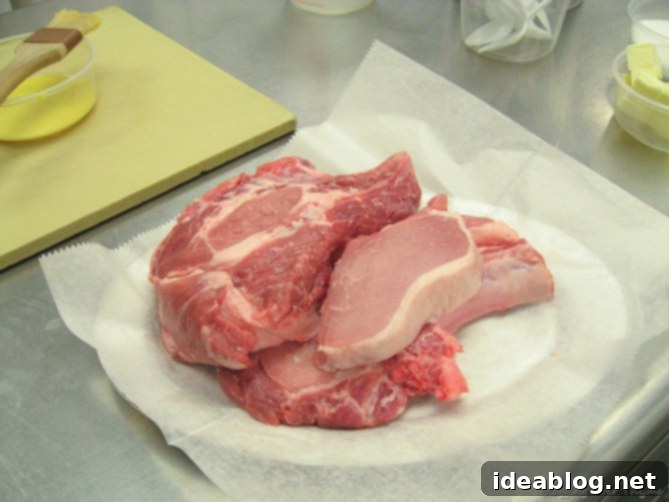
Exploring Pork: La Côte de Porc Poêlée with Sauce Charcuterie
Our main course introduced us to a protein that was largely *new* to our culinary school curriculum and, frankly, somewhat unfamiliar in my personal cooking repertoire: PORK. Beyond the occasional pork tenderloin, I haven’t ventured much into preparing various cuts of pork. This class was a significant step forward, demystifying a protein I’ve always found a little intimidating. The goal is to feel completely confident cooking it by the end of this program, and today certainly built a strong foundation.
Our featured pork dish was LA COTE DE PORC POELEE, which translates to pan-seared boned pork loin. It was elegantly paired with LA SAUCE CHARCUTERIE, a rich and tangy accompaniment that perfectly complements the succulent meat. The technique for pan-searing involved heating a sautoire pan to a high temperature, adding clarified butter, and then searing both sides of the pork loin until beautifully browned and caramelized. This initial searing creates a flavorful crust and locks in the juices. After achieving the desired sear, the pork was transferred to the oven to finish cooking gently and evenly. We learned a tactile method for checking doneness: with pork, the meat should feel mostly firm to the touch, indicating it’s cooked through but still tender and juicy.
Crafting the Classic Charcuterie Sauce
Once our pork chops were resting, we immediately embarked on preparing the sauce. Charcuterie sauce is a classic derivative of Sauce Robert, a foundational French pan sauce known for its piquant and savory profile. Sauce Robert typically incorporates white wine, white vinegar, finely diced shallots, and Dijon mustard. Our Charcuterie variation built upon this base, adding another layer of complexity and flavor.
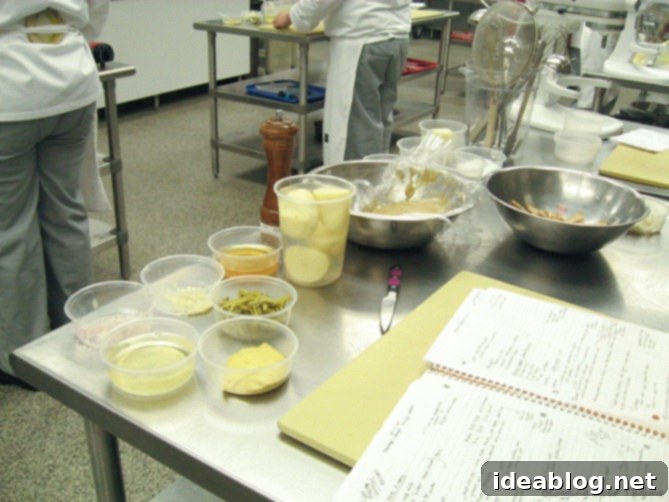
We utilized the same glazed sautoire pan where the pork was seared – crucial for capturing all the flavorful fond left behind. Into this pan, we added our shallots and, optionally, garlic, sautéing them until fragrant. The pan was then deglazed with white wine, followed by the addition of the remaining Sauce Robert ingredients and, importantly, some rich pork jus. The distinctive element that transforms this into a true charcuterie sauce is the incorporation of julienned cornichons (or gherkins), which are small, tart French pickles. As you might deduce from the inclusion of vinegar and pickles, this pan sauce has a notable acidity. However, it’s precisely this acidity that makes it an ideal companion for a rich pork loin, especially one marbled with a good amount of fat. The acid masterfully cuts through the richness, balancing the flavors beautifully.
The Art of Creamy Mashed Potatoes: La Pomme Puree
Our succulent pork loins were served alongside LA POMME PUREE, which is the French term for mashed potatoes. However, this was no ordinary mash. We were taught the official, time-honored technique for creating the creamiest, most luxurious mashed potatoes imaginable – a staple of classic French cuisine.
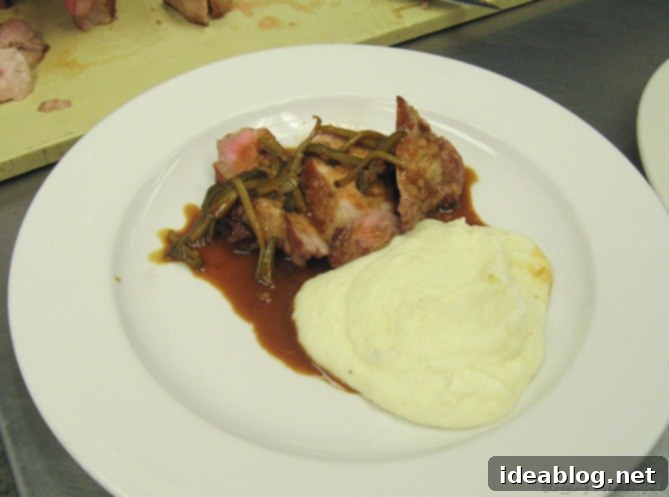
The process begins with cooking the potatoes until perfectly tender, then immediately passing them through a potato ricer. Ricing is key, as it breaks down the potato without activating too much starch, preventing a gluey texture. The riced potatoes are then briefly returned to the pan over low heat to allow some of their moisture to evaporate, ensuring a drier, fluffier base. The magic then happens with the generous addition of warm heavy cream and cold, cubed butter. During Chef Brian’s demonstration, he prepared mashed potatoes from just three potatoes but incorporated close to half a pound of butter and at least a cup of heavy cream! These mashed potatoes are indeed incredibly decadent and rich – certainly not for the faint of heart, or for those counting calories!
Chef Brian emphasized that these aren’t meant to be served in typical ginormous American portions. In a classic French setting, you would typically receive a small, elegant quenelle of mashed potatoes. Their intense richness and satisfying density mean that even a small serving is incredibly filling and satisfying, making them a luxurious complement to any main course.
A Refreshing Starter: French Gaspacho
In addition to our hearty meat and potatoes, we also prepared gaspacho (using the French spelling). This refreshing cold soup wasn’t made entirely today; the ingredients were meticulously prepped yesterday afternoon and allowed to marinate overnight. This crucial overnight rest allows the flavors to meld and deepen, creating a more harmonious and complex profile.
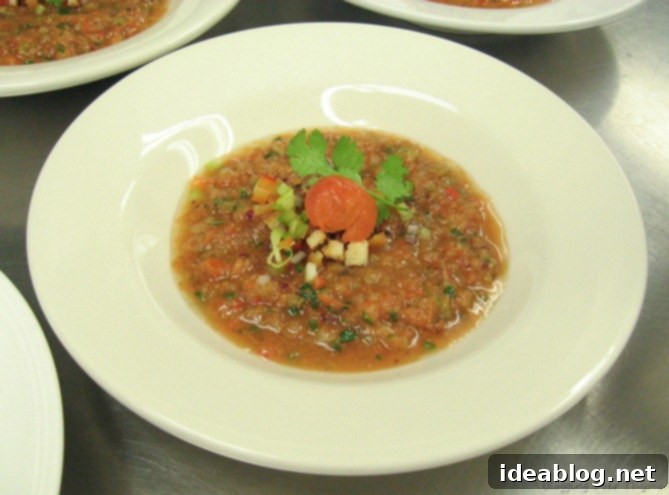
Our gaspacho was a vibrant medley of fresh ingredients, including red onion, tomatoes (which we blanched, de-seeded, and carefully cut), cucumber, cilantro, celery, red bell pepper, spring onion, and garlic. These fresh components were beautifully enhanced by an array of aromatics and seasonings: toasted cumin seed for a warm earthiness, Worcestershire sauce for umami depth, Tabasco for a subtle kick, rich olive oil, and the bright tang of sherry wine vinegar. Instead of a food processor or blender, we used a unique method for achieving the perfect texture: a meat grinder attachment for a KitchenAid stand mixer. This unconventional choice was brilliant because it broke down the vegetables without over-blending them into a completely smooth liquid. The result was a gaspacho with wonderful texture and body, offering a delightful mouthfeel rather than a uniform puree.
To finish, we garnished the gaspacho with a brunoise (1/8 inch cubes) of the main ingredients – perfectly diced tomato, cucumber, and pepper – along with some brunoised croutons, adding both visual appeal and a delightful crunch. It was a truly satisfying and elegant starter!
The Sweet Finale: Classic Coffee Éclairs
Of course, no day in French culinary school would be complete without indulging in a pastry creation. Today’s sweet endeavor was a classic: éclairs! These are a delightful variation of the cream puffs we mastered last week, demonstrating the versatility of a fundamental French dough.
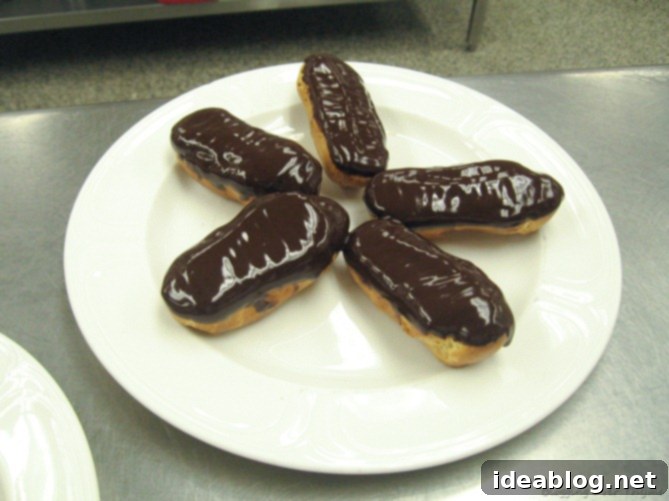
Éclairs, like their cousins cream puffs and profiteroles, are made from pâte à choux dough. This remarkable dough is created from a cooked mixture of milk, butter, salt, and flour, which then forms a rich, pliable paste. Once cooled slightly, eggs are beaten in, creating a dough that puffs dramatically when baked. We piped this dough into elegant 3-4 inch long stripes, which then baked into their characteristic hollow, elongated shapes.
Once the éclairs were perfectly baked, golden brown and airy, we filled them with a luxurious pastry cream. Today’s twist was flavoring the classic pastry cream with rich coffee paste, adding an aromatic depth that was truly exquisite. Finally, each éclair was dipped into a glossy chocolate glaze, a decadent mixture made with butter, both semi-sweet and unsweetened chocolate, and just a tiny bit of corn syrup to achieve that perfect sheen. These éclairs were dangerously good! I honestly didn’t realize I was such a fan until I tasted one made with such care and precision. It just goes to show, a truly well-made classic can transform your palate.
The Unsung Hero: Kitchen Clean-Up
Our culinary adventures were, as always, followed by thorough clean-up – an essential, albeit not always “fun,” task in any professional kitchen environment. It’s part of the discipline and routine, and frankly, a good mini-workout! Today, I took charge of sweeping the kitchen floors and maneuvering the massive mop and bucket. This daily hard labor is an inevitable and necessary chore when working in a professional kitchen, teaching us not just how to cook, but how to maintain a spotless and efficient workspace.

Now, it’s back to the books for more studying! I have a pretty good intuition about some of the dishes we might be required to prepare for the practical exam (Hollandaise sauce, for instance!), but I’ve been diligently practicing my tourneed potatoes in the kitchen. They are already significantly better than they were on that challenging first day, but achieving perfection with this classic turning technique is definitely a work in progress.
I don’t anticipate having a chance to update tomorrow, so be sure to check back on Thursday for a full recap of our practical test day. Trust me, I already have an idea of what’s on tomorrow’s menu, and you absolutely won’t want to miss it!
